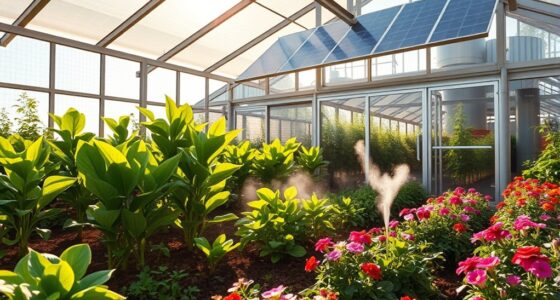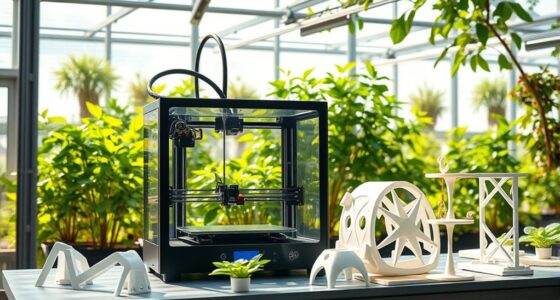To maximize heat retention with thermal mass, focus on selecting dense materials like concrete, brick, or stone that absorb and slowly release heat. Position these materials on interior sides of exterior walls or floors that receive sunlight to enhance solar gain. Combine this with proper insulation to prevent heat loss and control moisture. These strategies work together to create energy-efficient, temperature-stable spaces that reduce reliance on mechanical heating or cooling—discover more techniques to optimize your building’s thermal performance.
Key Takeaways
- Use high-density materials like concrete, brick, or stone in interior walls or floors to maximize heat storage.
- Position thermal mass materials on sun-exposed interior surfaces to leverage solar gain for heat retention.
- Combine thermal mass with proper insulation to prevent heat loss and enhance overall energy efficiency.
- Incorporate reflective coatings or vapor barriers to improve heat retention and control moisture.
- Strategically balance insulation and thermal mass placement to regulate indoor temperature fluctuations effectively.

Thermal mass strategies are essential tools in designing energy-efficient buildings, as they help regulate indoor temperatures by absorbing, storing, and releasing heat. When it comes to maximizing heat retention, your choice of insulation techniques and material selection plays a crucial role. Proper insulation not only prevents heat from escaping but also complements thermal mass efforts, ensuring the building maintains a comfortable temperature with less energy input. By integrating effective insulation techniques, you can minimize thermal bridging and air leaks, which are common sources of heat loss. Think about using high-quality insulation materials like spray foam, rigid foam boards, or mineral wool, depending on your specific needs and building design. These materials provide excellent thermal resistance, helping to lock in warmth during colder months and keeping the interior cooler when it’s hot outside.
Effective insulation materials like spray foam and mineral wool enhance thermal mass strategies.
Material selection is another key aspect. Opting for dense, high-thermal-mass materials such as concrete, brick, or stone allows you to store significant amounts of heat. These materials absorb warmth during the day and slowly release it when temperatures drop, creating a natural buffer that stabilizes indoor climates. You might consider incorporating these materials into floors, walls, or even ceilings, depending on your project. The idea is to choose materials that have high specific heat capacities, enabling them to hold more energy per unit volume. When combined with well-placed insulation, these materials work synergistically to improve overall energy performance, reducing reliance on heating and cooling systems. Additionally, understanding the importance of thermal mass properties can help you select the most effective materials for your climate and building design.
In addition to selecting the right materials, positioning them strategically within your building is paramount. For example, placing high-density materials on the interior side of exterior walls or floors exposed to direct sunlight can maximize their heat-storing capabilities. Furthermore, combining thermal mass with insulation techniques such as vapor barriers or reflective coatings can enhance heat retention by controlling moisture and reducing radiative heat transfer. The goal is to create a balanced system where insulation minimizes heat loss, while thermal mass moderates temperature fluctuations, leading to a comfortable indoor environment year-round.
Ultimately, your success in utilizing thermal mass strategies hinges on thoughtful material selection and insulation techniques. By choosing the right materials with high thermal capacities and integrating effective insulation methods, you can design spaces that naturally retain heat, cut energy costs, and reduce environmental impact. These strategies work hand-in-hand to create buildings that are not only energy-efficient but also more comfortable and resilient against climate variations. Your focus on these foundational elements ensures that thermal mass becomes a powerful tool in your sustainable building toolkit.
Frequently Asked Questions
How Does Thermal Mass Affect Indoor Air Quality?
Thermal mass can improve indoor air quality by stabilizing temperatures, reducing the need for constant heating or cooling, and allowing better ventilation efficiency. When thermal mass absorbs and releases heat slowly, it prevents temperature swings that can cause discomfort or mold growth. This stabilization encourages proper ventilation, helping to remove indoor air pollutants more effectively. As a result, you experience fresher, healthier indoor air with less temperature-related irritation.
Can Thermal Mass Strategies Be Combined With Renewable Energy Systems?
Imagine a perfect harmony—yes, thermal mass strategies can be combined with renewable energy systems. You’ll want to focus on integrated design, ensuring your materials are compatible with renewable tech like solar or geothermal. This synergy enhances efficiency, reduces energy costs, and promotes sustainability. By aligning your thermal mass with renewable systems, you create a resilient, eco-friendly environment that maximizes energy use and minimizes waste—truly a win-win for your space.
What Are the Environmental Impacts of Thermal Mass Materials?
You should consider that thermal mass materials impact the environment through embodied energy, which is the energy used during their production, transportation, and installation. Many materials are recyclable, reducing waste and resource depletion. However, some have high embodied energy, increasing their environmental footprint. Choosing recyclable materials with lower embodied energy helps minimize negative effects and promotes sustainable building practices, benefiting both the environment and future generations.
How Long Does It Take for Thermal Mass to Stabilize Indoor Temperatures?
It usually takes just a few days for thermal mass to stabilize indoor temperatures, but sometimes it feels like an eternity! Thermal mass slowly absorbs heat during the day and releases it at night, helping your home maintain a consistent temperature. The exact time depends on factors like material type, insulation, and climate. Typically, within 3 to 7 days, you’ll notice temperature stabilization, making your space more comfortable and energy-efficient.
Are There Specific Climate Zones Where Thermal Mass Is Most Effective?
In hot, dry climates, thermal mass works best by absorbing daytime heat and releasing it at night. You should focus on climate-specific strategies and regional material choices to maximize effectiveness. For cooler regions, thermal mass helps retain warmth during cold nights. You’ll need to adapt your design based on your climate zone, selecting materials like concrete or brick suited to your area’s temperature swings, ensuring ideal heat retention and comfort.
Conclusion
By applying these thermal mass strategies, you’ll keep your space warm like a cozy hug on a chilly day. Think of thermal mass as a silent guardian, absorbing heat during the day and releasing it at night. With simple adjustments, you’ll create a comfortable environment that minimizes energy use and maximizes efficiency. Embrace these techniques, and you’ll experience the lasting warmth and comfort that come from smart thermal mass choices—just like a well-wrapped blanket on a cold evening.










